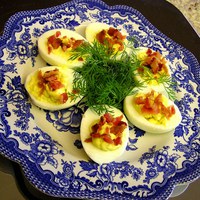Prairie Fare: Crack Some Eggs
(Click an image below to view a high-resolution image that can be downloaded)
By Julie Garden-Robinson, Food and Nutrition Specialist
NDSU Extension Service
A couple of weeks ago, my daughters and I were preparing food one afternoon for guests arriving the next day. I wrote a list of things to do. My older daughter enjoys eggs, so she wanted to compete the “hard cook 1 dozen eggs” item from my list.
Although “hard-boiled” often is used to describe eggs used in egg salad, technically we should avoid boiling eggs for appearance reasons. If boiled too long, eggs can develop a green halo around the yolk due to a chemical reaction between the sulfur in the egg white and iron in the yolk.
The green-tinged eggs are not harmful, but they are most appealing to Dr. Seuss characters who like “green eggs and ham.”
My daughter requested that we add two more eggs to the pot so she could have a snack.
She followed the “how to hard-cook eggs” directions perfectly. She placed the large eggs in a saucepan and covered them with an inch of water. Then she heated them over high heat to boiling. Next, she removed the pan from the burner and covered the pan. Then she allowed them to stand 12 minutes. Finally, she cooled them under cold, running water.
Next, she took an “egg break.” She peeled an egg, and we could see no green around the yolks. She put the remaining eggs back in the carton and refrigerated them.
Eggs are a healthful and budget-friendly food. They provide 6 grams of high-quality protein per egg at less than 20 cents per egg, on average.
Egg yolks provide the pigment lutein, which is especially good for our eyes. In fact, having enough lutein in our diet from eggs, corn and dark, leafy greens may help reduce our risk for age-related macular degeneration and cataracts as we get older.
According to Purdue University researchers, you might want to add a hard-cooked egg to your vegetable salad. When you consume eggs with vegetables, your body may be better able to use the natural pigments in the vegetables.
If you have an 80-calorie egg for breakfast, you may not feel hungry as quickly because of the protein and fat the egg contains. Some research has shown that eggs may play a role in weight loss as part of an overall reduced-calorie diet.
Although old health advice told us to avoid eggs, nutrition experts now agree that one egg per day is considered fine for most people. Researchers have shown that the cholesterol in eggs does not increase the blood cholesterol level in the body.
However, before making any major diet changes, be sure to consult with your health-care provider. Along with an egg, have some whole-grain toast, fruit and yogurt to round out your breakfast.
Egg yolks also provide choline, which is included among the B vitamins. Choline plays a role in nerve, muscle and kidney function.
As I was pondering the benefits of eggs, I didn’t see where my daughter placed the egg carton in the fridge. My younger daughter was ready to proceed with her task: coloring the eggs for our holiday meal.
My older daughter said they were on the second shelf in the refrigerator, so I opened the right-hand side of the fridge, found the carton and placed it on the counter. My younger daughter prepared the cups of colored liquid to dye the eggs. While she was busy coloring eggs, I worked on other food preparation.
I stepped over to admire her progress as she moved the colored eggs from the cups back to the carton. They looked a little blotchy to me, but that gave them an interesting pattern. I figured we needed to stir the dye a little more.
The next day, I removed the carton of brightly colored eggs from the refrigerator. The first egg I touched was stuck in the carton, so I twisted it a bit. In doing so, I crushed the egg in my hand and the gooey white and yolk flowed all over the counter and down the cupboard.
Yes, we had two cartons of eggs on opposite sides of the second shelf of the refrigerator: one cooked and one raw.
We had uncolored cooked eggs for the holiday and now we have colored raw eggs for baking. We keep learning lessons every day. Next time, we will the mark the carton “cooked.”
Although I didn’t put the eggs in the dye, the blotchiness during dying should have been my visual clue. Commercial eggs typically are washed before packing. This process removes the natural “bloom” on eggs, which functions to reduce moisture loss and helps prevent bacteria from entering the eggs through the pores.
Some egg packers treat eggs with a light coating of edible mineral oil. The eggs my younger daughter colored might have had a light coating of oil on them.
Eggs are versatile ingredients that can be cooked, poached, scrambled, used in omelets and added to a variety of cooked or baked dishes.
Eggs have many functions in cooking and baking. For example, they help bind together ingredients when you make meat loaf or meatballs. They serve as leavening agents in making cakes, and they help thicken custards. Eggs also add nutrition and flavor to foods.
Here’s a simple way to use hard-cooked eggs, and it’s one of my favorites.
Heavenly Deviled Eggs
6 large eggs (in shell)
2 Tbsp. light mayonnaise
1 tsp. mustard (or substitute a sprinkle of black pepper and salt)
Optional garnishes (paprika, dried dill, sliced scallions, crisp bacon bits, sliced black olives, etc.)
Place eggs in a saucepan in a single layer and cover with water. Bring to a boil, then remove from heat. Cover and allow to stand for 12 minutes. Drain water and cool under cold, running water. Peel eggs carefully. Split eggs in half lengthwise and remove yolks. Place yolks, dressing and mustard into a small zipper-lock plastic bag and squeeze to mix. Cut a small hole in the corner of the bag. Squeeze mixture into egg white halves. Garnish as desired.
Makes six servings (two egg halves). A serving has 90 calories, 6 grams (g) fat, 6 g protein, 1 g carbohydrate, 0 g fiber and 174 milligrams sodium.
(Julie Garden-Robinson, Ph.D., R.D., L.R.D., is a North Dakota State University Extension Service food and nutrition specialist and professor in the Department of Health, Nutrition and Exercise Sciences.)
NDSU Agriculture Communication - April 7, 2016
| Source: | Julie Garden-Robinson, 701-231-7187, julie.garden-robinson@ndsu.edu |
|---|---|
| Editor: | Ellen Crawford, 701-231-5391, ellen.crawford@ndsu.edu |



